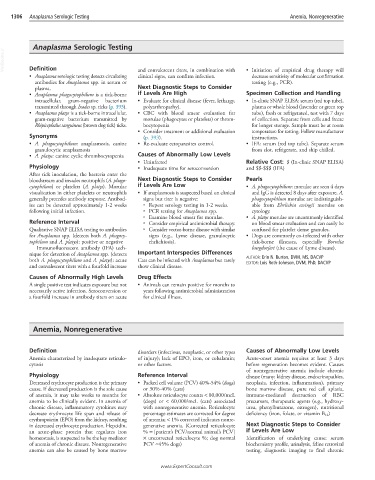Page 2585 - Cote clinical veterinary advisor dogs and cats 4th
P. 2585
1306 Anaplasma Serologic Testing Anemia, Nonregenerative
Anaplasma Serologic Testing
VetBooks.ir Definition
decrease sensitivity of molecular confirmation
• Anaplasma serologic testing detects circulating and convalescent titers, in combination with • Initiation of empirical drug therapy will
clinical signs, can confirm infection.
antibodies for Anaplasma spp. in serum or testing (e.g., PCR).
plasma. Next Diagnostic Steps to Consider
• Anaplasma phagocytophilum is a tick-borne if Levels Are High Specimen Collection and Handling
intracellular, gram-negative bacterium • Evaluate for clinical disease (fever, lethargy, • In-clinic SNAP ELISA: serum (red top tube),
transmitted through Ixodes sp. ticks (p. 393). polyarthropathy). plasma or whole blood (lavender or green top
• Anaplasma platys is a tick-borne intracellular, • CBC with blood smear evaluation for tube), fresh or refrigerated, test with 7 days
gram-negative bacterium transmitted by morulae (phagocytes or platelets) or throm- of collection. Separate from cells and freeze
Rhipicephalus sanguineus (brown dog tick) ticks. bocytopenia for longer storage. Sample must be at room
• Consider treatment or additional evaluation temperature for testing. Follow manufacturer
Synonyms (p. 393). instructions.
• A. phagocytophilum: anaplasmosis, canine • Re-evaluate ectoparasites control. • IFA: serum (red top tube). Separate serum
granulocytic anaplasmosis from clot, refrigerate, and ship chilled.
• A. platys: canine cyclic thrombocytopenia Causes of Abnormally Low Levels
• Uninfected Relative Cost: $ (In-clinic SNAP ELISA)
Physiology • Inadequate time for seroconversion and $$-$$$ (IFA)
After tick inoculation, the bacteria enter the
bloodstream and invades neutrophils (A. phago- Next Diagnostic Steps to Consider Pearls
cytophilum) or platelets (A. platys). Morulae if Levels Are Low • A. phagocytophilum: morulae are seen 4 days
visualization in either platelets or neutrophils • If anaplasmosis is suspected based on clinical and IgG is detected 8 days after exposure. A.
generally precedes antibody response. Antibod- signs but titer is negative: phagocytophilum morulae are indistinguish-
ies can be detected approximately 1-2 weeks ○ Repeat serology testing in 1-2 weeks. able from Ehrlichia ewingii morulae on
following initial infection. ○ PCR testing for Anaplasma spp. cytology.
○ Examine blood smear for morulae. • A. platys morulae are uncommonly identified
Reference Interval ○ Consider empirical antimicrobial therapy. on blood smear evaluation and can easily be
Qualitative SNAP ELISA testing to antibodies ○ Consider vector-borne disease with similar confused for platelet dense granules.
for Anaplasma spp. (detects both A. phagocy- signs (e.g., Lyme disease, granulocytic • Dogs are commonly co-infected with other
tophilum and A. platys): positive or negative ehrlichiosis). tick-borne illnesses, especially Borrelia
Immunofluorescent antibody (IFA) tech- burgdorferi (the cause of Lyme disease).
nique for detection of Anaplasma spp. (detects Important Interspecies Differences
both A. phagocytophilum and A. platys): acute Cats can be infected with Anaplasma but rarely AUTHOR: Erin N. Burton, DVM, MS, DACVP
EDITOR: Lois Roth-Johnson, DVM, PhD, DACVP
and convalescent titers with a fourfold increase show clinical disease.
Causes of Abnormally High Levels Drug Effects
A single positive test indicates exposure but not • Animals can remain positive for months to
necessarily active infection. Seroconversion or years following antimicrobial administration
a fourfold increase in antibody titers on acute for clinical illness.
Anemia, Nonregenerative
Definition disorders (infectious, neoplastic, or other types Causes of Abnormally Low Levels
Anemia characterized by inadequate reticulo- of injury); lack of EPO, iron, or cobalamin; Acute-onset anemia requires at least 3 days
cytosis or other factors. before regeneration becomes evident. Causes
of nonregenerative anemia include chronic
Physiology Reference Interval disease (many: kidney disease, endocrinopathies,
Decreased erythrocyte production is the primary • Packed cell volume (PCV) 40%-54% (dogs) neoplasia, infection, inflammation), primary
cause. If decreased production is the sole cause or 30%-40% (cats) bone marrow disease, pure red cell aplasia,
of anemia, it may take weeks to months for • Absolute reticulocyte counts < 80,000/mcL immune-mediated destruction of RBC
anemia to be clinically evident. In anemia of (dogs) or < 60,000/mcL (cats) associated precursors, therapeutic agents (e.g., hydroxy-
chronic disease, inflammatory cytokines may with nonregenerative anemia. Reticulocyte urea, phenylbutazone, estrogen), nutritional
decrease erythrocyte life span and release of percentage estimates are corrected for degree deficiency (iron, folate, or vitamin B 12)
erythropoietin (EPO) from the kidney, resulting of anemia; < 1% corrected indicates nonre-
in decreased erythrocyte production. Hepcidin, generative anemia. (Corrected reticulocyte Next Diagnostic Steps to Consider
an acute-phase protein that regulates iron % = [patient’s PCV/normal animal’s PCV] if Levels Are Low
homeostasis, is suspected to be the key mediator × uncorrected reticulocyte %; dog normal Identification of underlying cause: serum
of anemia of chronic disease. Nonregenerative PCV ≈45% dogs) biochemistry profile, urinalysis, feline retroviral
anemia can also be caused by bone marrow testing, diagnostic imaging to find chronic
www.ExpertConsult.com

